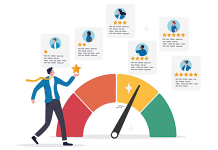With a potential economic recession looming, key B2B decision-makers within sales organizations are assessing how to cut costs and preserve margins. It’s imperative to develop a firm understanding of which investments can effectively generate revenue and enable their organization to weather the storm.
Leveraging data to drive decision-making is a critical component to building that resilience. Through the adoption of sales enablement automation solutions, sales leaders can use real time, AI-powered feedback loops to determine what is driving buyer engagement, converting sales and maximizing ROI. Before chopping and changing, B2B decision-makers should first explore how their existing automation tools can forge new pathways to profitability amidst economic uncertainty.
Keeping Customers Around
Everyone knows it is more difficult to attract new prospects than it is to retain existing customers. This struggle is compounded by the fact that consumer loyalty levels have reached all-time lows. Focusing on delivering meaningful buyer experiences is an effective way to ensure they keep coming back.
That requires a deeper understanding of their buyer preferences. While certain variables like price points and customer service play a primary role in buyer loyalty, brands also need to consider the human-centric element. According to one eMarketer survey, 57% of companies rank creating an emotional connection as a primary driver for their loyalty investments.
The widespread shift to virtual selling may feel less personalized at times, but it has provided sales reps more tools to learn about their prospects and foster impactful connections. Sellers now have the ability to measure buyer engagement and responsiveness in real time by leveraging insights generated from AI-powered tools including conversation intelligence.
During a virtual product presentation, they can measure which buyers were most engaged and, in turn, prioritize the right leads at the right times to boost revenue.
With customers willing to switch suppliers more than ever before, ensuring that your sales team is buyer-ready requires harnessing customer touchpoint data from live interactions. Investing in each interaction by tracking customer reactions down to the smallest intricacies provides sellers with unprecedented visibility into what is resonating with customers and prospects alike.
Hold On to What’s Working
When making budgetary decisions, especially pertaining to spending cuts, businesses must be able to decipher what is working from what is not. For example, measuring the effectiveness of marketing content can present its fair share of challenges. For starters, a majority of marketing collateral often goes unused. By some estimates, only 35% of marketing content is used during the B2B sales process — a trend that isn’t indicative of the quality (or lack thereof ) of the actual content.
In order to gain real, actionable feedback on what content assets are supporting meaningful prospect interactions, organizations need to utilize platforms that automate the analysis of buyer engagement. Does the content effectively articulate value and relevance to the prospect? Does it appeal to the specific challenges of their industry? Is it accessible across multiple channels and devices? These are the kinds of questions that must be top of mind.
Sellers now can quickly deliver content, monitor its engagement levels, and then adjust their approaches accordingly. Creating a web of data around customer touchpoints offers visibility into the fundamental components of closing a deal. Just because marketing content is going unused doesn’t mean you should throw the baby out with the bathwater. It can make a major impact on revenue as long as it’s leveraged effectively.
Don’t Leave Money on the Table
B2B sales organizations already have a wide range of data to leverage for revenue generation, but the power of that data is dependent on their ability to act on it. When staring down a potential economic recession, it’s important to pause and assess how your existing infrastructure can help you do more with less. Is each buyer/seller interaction building emotional currency? Are content assets being overlooked due to irrelevance or complexity?
Empowering your sales and marketing teams starts with data-driven decisioning. With sales enablement automation, organizations have the tools and technologies to remove uncertainty from their spending decisions. Before making rash decisions, businesses should take a more calculated, data-driven approach. It just might be the bridge that gets them to the other side.




